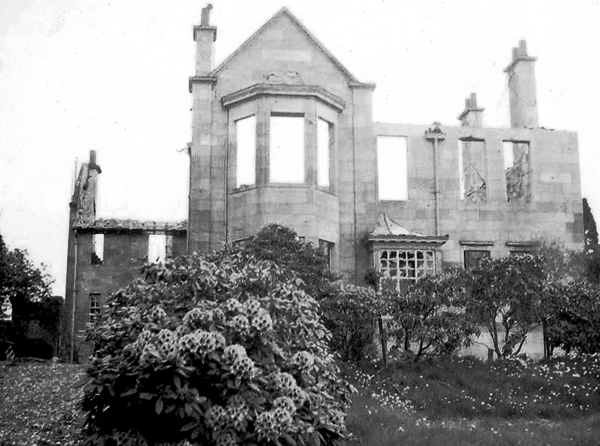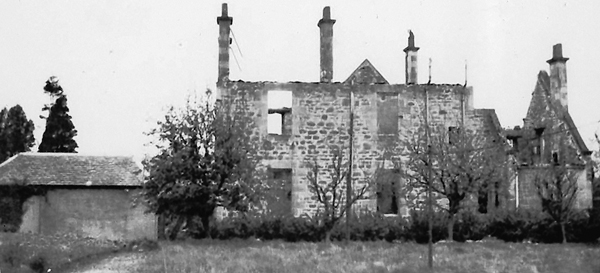CARDROSS village and the surrounding area suffered three deaths and significant and widespread damage when the Luftwaffe bombed it over the night of May 5 1941.
It is believed that — although a German propaganda broadcast later spoke of "the port of Cardross” — the pilots were fooled by a hilltop decoy site near Kipperoch, between Cardross and Renton which was hit by 205 bombs and six mines.
Andrew Jeffrey, author of the book ‘This Time of Crisis’, is in no doubt that it was the proximity of Cardross to this site that led to the bombing of the village.
A heavy anti-aircraft battery behind the village armed with 3.7-inch or 4.5-inch guns, one of a series built following heavy bombing raids on Glasgow, could do little to protect residents that night.
A terrifying few hours on one of the local farms, Kirkton, has been graphically described by the farmer at that time, the late James Weir, on this website, and recently villager Derek Camlin published a previously unpublished emotional account of that night written his grandfather.

His grandfather was William Camlin (right), who lived at Rose Cottage in Smithy Road, the family home for four generations.
Born in Cardross in 1884, he spent over 50 years of his working life as a pattern maker in Denny's shipyard in Dumbarton, and he passed away in 1979.
This is Mr Camlin’s account . . .
This is my own recollection of the blitz, and I state here a true report of how it affected me and what took place around the environs of Rose Cottage.
The blitz started first on the stroke of midnight 6th/7th May 1941.
The incendiaries were well alight to the north below Cairniedrouth farm when I got out of the house, with the zooming of the planes overhead, and
sometime after, a shower of incendiaries falling nearer and nearer till I could hear the swish and hissing they made as they streamed earthwards.
In fact I was standing in the garden looking up to the sky trying to see if I could spot any planes, but I could not. Then the incendiaries came down all around where I and my son-in-law were standing.
Sixty three in all fell within the garden, and some not a yard away at my feet. We were kept very busy burying them and putting out fires which were started.
Although fortunately none went through the roof of the house, several were explosive, and one sent splinters of molten fire inside my son's boot.
He hopped over to the Police Station where the dressing station was, but he could get no assistance nor dressing there.
Those available to give medical assistance were all, like most other people who were supposed to be able to take it, hiding and shaking like frightened rats; and even the next day there was no one there who could attend to him.
In fact everybody who could cleared out, even the ministers with their motor cars, and every night for weeks afterwards people took to the hills and those with cars spent the night sitting in them up Loch Lomondside.
Firemen and civil service people alike all cleared out.
The night of the blitz, some were flocking down the wood to the shore, but even there they could not escape, for bombs fell everywhere — in the wood, in the fields and around, and all along the shore. Up the hills it was just as bad.
It was a hellish time with the whine of the bombs as they screeched downwards, then the thuds which shook the ground, and with the noise of
the explosions, the stink of the gas which parched your mouth and nipped your eyes, with everything that could move rattling, the houses shaking and your whole system quaking with fear.
I never was as tired in all my life. I am sure if I lay down on my face once I must have been up and down hundreds of times. The wood with all the dry undergrowth was well ablaze and must have given a good target for the Germans.
Many more houses in the village would have been burned and gutted out if it had not been for the occupants dealing promptly with the incendiaries, and some that were burned would have been saved, only the tenants had cleared out and were hiding down at the burns, or running here and there looking for safety.
It is all very well when one looks back on that night now to talk about how things should have been done, but believe me that everybody old and young
alike was dead scared, myself included.
It was pitiful to see mothers running with their little children, looking for safety where there was nothing but bombs dropping all around.
For three hours they kept It up, wave after wave of bombers coming in dropping fire bombs, high explosives and land mines, and tens of thousands of incendiaries.
I have no doubt but that there were plenty of heroic deeds performed by lots of people, but I am just stating what I saw and what actually took place as far as I could observe round about our house.
There have been several published accounts of that night, but an overview was provided by librarian and historian Arthur F.Jones in his 1985 book ‘Cardross: The village in days gone by’, published by Dumbarton District Libraries but no longer available for sale.
He noted that for security reasons the Lennox Herald reporter had to refer to “a village on Clydeside”, which suffered severely in the raid. It was not until June 28 that Cardross could be identified.
Mr Jones continued: “The alert had sounded about midnight on the 5th May, and soon the incendiaries, delayed action bombs etc. began to have disastrous effects.

“The following properties were destroyed completely Cardross Old Parish Church and a cottage across the road (home of Mr William Nicol); Cardross Golf Clubhouse; The Cottage (Mr Hay’s), and a smaller cottage (Mr Keywood senior’s), both in Peel Street; a cottage in Blairquhomrie Wood occupied by the aged Peter Wilson; Borrowfield House (Lady Denny’s) - where Bali Hi now stands; "Glenlee” (top and right) (McIntyre family, Sawmill) - only the shell remained, but it is now rebuilt; semi-detached villas (homes of Mr Shanks and Mr Vallance) on the main road between the Muirholm Hotel and Barrs Crescent; Hope Terrace opposite the Geilston Hall; an old cottage at the foot of the Murrays Road; Barrs Farm; Mollandhu Farmsteading and house.
“Some notable properties which were damaged were: Ardenvohr House; Cardross Mill; the railway footbridge at the east end of the station; and Geilston Hall.
“In addition many more homes in the village suffered caved-in ceilings and blown-in windows, and there were many near misses. Several hundred craters were seen scattered throughout the village the following day.
“The fire-fighting efforts of the villagers during the worst period were tremendous and only a limited amount of outside assistance was possible.
“Those near the Parish Church were just getting ready to tackle the blaze when another high explosive bomb fell through the roof and destroyed the main part of the building.
“The bell seen crashing to the ground and rolling to the doorway. The church records were fortunately saved. Other bombs fell on the churchyard and the manse grounds, shrapnel causing damage to many of the gravestones.
“Mercifully casualties were few. Only one person died ‘on the spot’, but one or two elderly people did not survive much longer, having received a great shock as a result of the calamity in general or of the damage to their homes in particular.
“Younger people worked hard in the ensuing months to repair damage. The Weirs at Kirkton Farm, who had suffered the loss of glasshouses, a boilerhouse and various outbuildings, had within a year rebuilt the tomato houses and other buildings, cleared the debris, and filled in the surrounding craters.”





